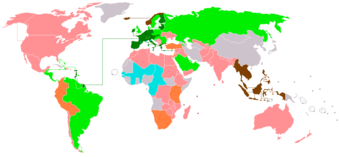Preferential Trade Agreement 05/05/2019 – Posted in: Daily News
PREFERENTIAL TRADE AGREEMENT
For: Mains
Topics Covered: PTA, Lists of agreements, Objectives & Benefits, Margin of Preference
News Flash
India seeks more tariff concessions from Chile during talks for further expansion of the India-Chile Preferential Trade Agreement (PTA). Officials from both countries met in New Delhi for further expanding the India-Chile PTA and issues relating to trade in goods, SPS/TBT, Customs, Rules of Origin etc under the existing PTA.
Also both countries seeks further expansion of the PTA for inclusion of more tariff lines/ increasing Margin of Preference (MoP).
Present Status
Under the current expanded PTA, India has increased tariff concessions to Chile from 178 tariff lines to 1031 tariff lines and Chile’s concession to India have increased from 296 tariff lines to 1784 tariff lines at 8-digit HS code 2012.
Presently, Chile offers duty concessions on as many as 1,798 goods to Indian exporters compared to 178 items earlier. And India has offered concessions to Chile on 1,031 products as against 296 earlier, at 8-digit level with MoP ranging from 10-100 per cent.
Background
As Chile is the founding member of the Pacific Alliance to which India is an observer member, further expansion of the PTA is expected to strengthen relations between them and enhance India’s engagement with the emerging trade bloc.
The expansion of the India-Chile was signed in 2017 which substantially increased the bilateral trade between the two countries.
A PTA between India and Chile was earlier signed on March 8, 2006, and came into force from August 2007. In the original PTA concluded in March 2006, India had offered 178 tariff lines with the MoP ranging from 10-50 per cent at 8-digit level and Chile’s offer list consisted of 296 tariff lines with MoP ranging from 10-100 per cent at the 8-digit level.
Margin of Preference (MoP)
The term ” margin of preference ” means the absolute difference between the most-favoured-nation rate of duty and the preferential rate of duty for the like product, and not the proportionate relation between those rates.
Preferential Trade Agreement
Preferential Trade Agreements (PTAs) or Generalized System of Preferences (GSP) is a special status given in trade by various countries. In the United States, it is designed to promote economic growth in the developing country, the agreement provides duty-free entry for up to 4,800 products from 129 designated beneficiary countries and territories. GSP was instituted on January 1, 1976, by the Trade Act of 1974, mentioned US government. India government, however, thinks the plan has been proliferating since the establishment of the World Trade Organisation (WTO) in 1994.
India’s trade agreements
- Partial Scope Agreement (PSA)
A PSA allows countries to trade in a small number of goods, making the scope minimal.
- Free Trade Agreement (FTA)
A free trade agreement is a preferential arrangement in which members reduce tariffs on trade among themselves while maintaining their own tariff rates for trade with non-members.
- Customs Union (CU)
A customs union (CU) is a free-trade agreement in which members apply a common external tariff (CET) schedule to imports from nonmembers.
- Common Market (CM)
A common market is a customs union where movement of factors of production is relatively free amongst member countries.
- Economic Union (EU)
An economic union is a common market where member countries coordinate macro-economic and exchange rate policies.
Indian treaties
According to the latest information updated by the Indian government dated in the 2016-17 budget report:
- India has signed bilateral FTAs with Sri Lanka (1998), Afghanistan (2003), Thailand (2004), Singapore (2005), Bhutan (2006), Nepal (2009), Korea (2009), Malaysia (2011) and Japan (2011).
- There have also been two regional trade agreements, the South Asian
- Free Trade Agreement (SAFTA, 2004) and the India-Association of Southeast Asian Nations Agreement (ASEAN, 2010).
- Outside Asia, FTAs have been agreed with Chile (2006) and MERCOSUR (2004).
- Trans-Pacific Partnership (TPP), which has been signed but not yet ratified by member countries, and the Trans Atlantic Trade and Investment Partnership (TTIP), which is currently being negotiated.
- The TPP comprises twelve member countries: Australia, Brunei, Canada, Chile, Japan, Malaysia, Mexico, New Zealand, Peru, Singapore, United States, and Vietnam, as shown in the map below. The TPP will cover 40 percent of global GDP2 and 33 percent of world trade.
- TTIP, when concluded, will be a PTA between the United States and the European Community of 27 member states.
Source: India Today
You can follow us on LinkedIn and for more updates related to UPSC IAS Preparation, Like our Facebook Page and subscribe our Diligent IAS Youtube Channel
Also Read Related Daily News
- International Centre for Automotive Technology
- U.S. Commission on International Religious Freedom
- Stucco Sculpture

